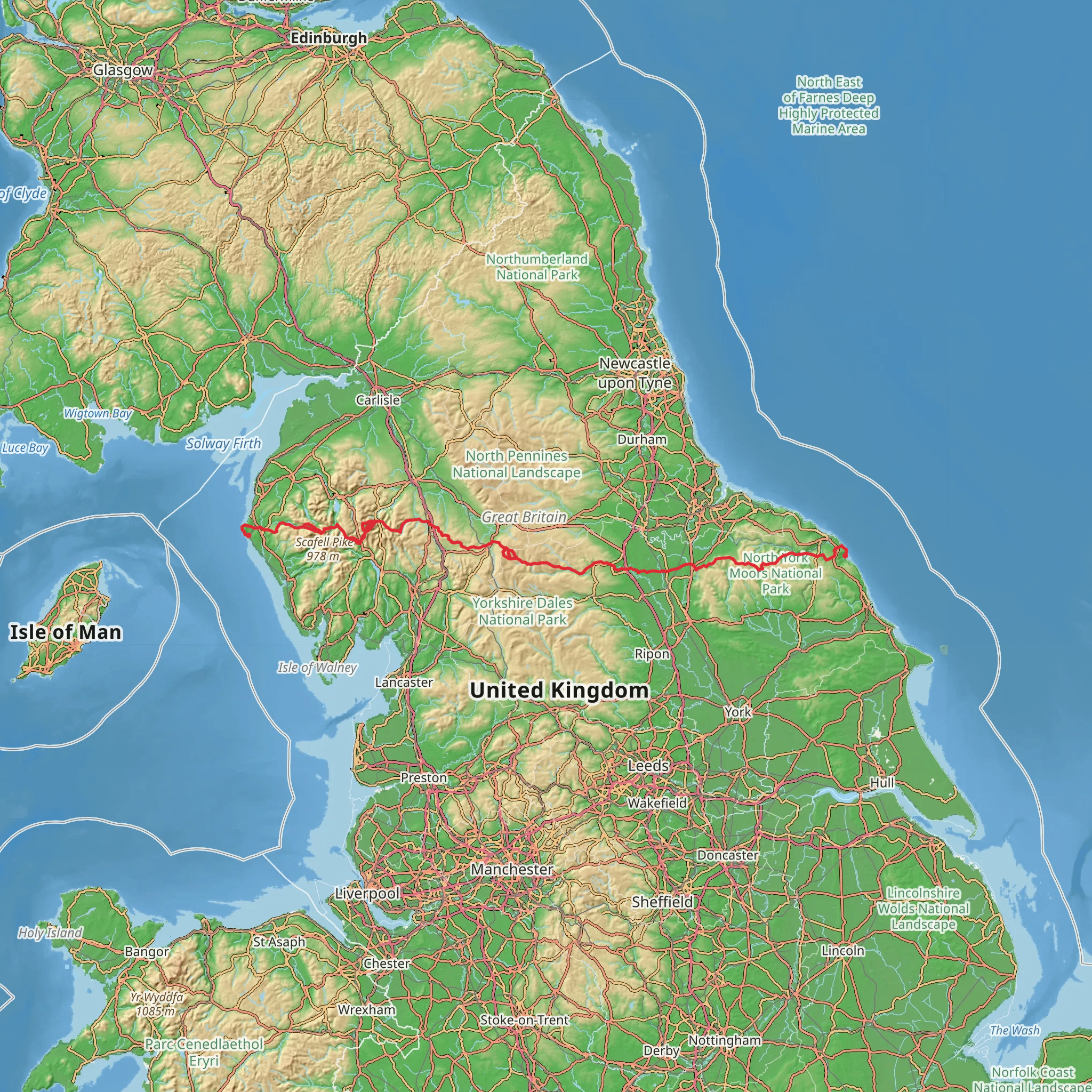Download
Preview
Add to list
More
292.1 km
~17 days
8657 m
Multi-Day
“Embark on England's epic Coast to Coast Walk, a journey through history, nature, and stunning national parks.”
Spanning approximately 292 kilometers (181 miles) and with an elevation gain of around 8600 meters (28,215 feet), the Coast to Coast Walk is a renowned long-distance footpath in England. This point-to-point trail traverses the country from the Irish Sea in the west to the North Sea in the east, starting near St Bees in Cumbria and ending at Robin Hood's Bay in North Yorkshire.
Getting to the Trailhead
To begin your journey on the Coast to Coast Walk, you can reach St Bees by train, with the nearest significant railway station being in Carlisle. From there, local trains run to St Bees station, which is a short walk from the trailhead. If you're driving, St Bees is accessible via the A595 road, and there is parking available in the village.
The Journey Through Three National Parks
The trail takes you through some of the most stunning landscapes in England, including three National Parks: the Lake District, the Yorkshire Dales, and the North York Moors. Each park offers its unique terrain and challenges.
In the Lake District, you'll encounter rugged mountains and serene lakes. This section includes some of the most significant elevation gains, with peaks like Helvellyn and the challenging ascent of Kidsty Pike. The Lake District is also steeped in literary history, having inspired poets like William Wordsworth and Beatrix Potter.
As you transition into the Yorkshire Dales, the landscape softens to rolling hills and valleys, known for their dry stone walls and barns. This area is rich in history, with ancient settlements and the iconic Ribblehead Viaduct, a testament to Victorian engineering.
The final National Park, the North York Moors, presents heather-clad moorland and forested areas. The trail's culmination at Robin Hood's Bay, a picturesque fishing village, is a dramatic finish as you descend to the sea cliffs overlooking the North Sea.
Wildlife and Nature
Throughout the walk, you'll encounter diverse wildlife, including red squirrels in the woodlands, birds of prey such as the peregrine falcon, and the occasional roe deer. The changing seasons bring different flora, from the springtime bluebells in the woodlands to the summer bloom of heather on the moors.
Navigation and Planning
Hikers should plan their journey carefully, considering the remote nature of some trail sections. Using a dedicated hiking app like HiiKER can help with navigation, providing detailed maps and waypoints. It's advisable to break the walk into manageable sections, with popular stopping points in towns like Grasmere, Richmond, and Osmotherley, where accommodation and services are available.
Preparation and Safety
Given the trail's length and varied terrain, a medium difficulty rating is appropriate. Hikers should be prepared for the English weather, which can be unpredictable, and carry appropriate gear for rain, wind, and, in some seasons, even snow. It's also essential to have good-quality hiking boots, as the terrain can be rough and rocky in places.
Historical Significance
The region is steeped in history, from the Roman legacy in the Lake District to the medieval castles and monasteries in the Yorkshire Dales. The Coast to Coast Walk itself was devised by Alfred Wainwright, a renowned British fellwalker, and author, and has become a rite of passage for many hikers from around the world.
Conclusion
By taking on the Coast to Coast Walk, hikers will not only challenge themselves physically but also have the opportunity to immerse themselves in the natural beauty and rich history of northern England. With careful planning and respect for the environment, this trail offers a rewarding and unforgettable experience.
What to expect?
Activity types
Comments and Reviews
User comments, reviews and discussions about the Coast to Coast Walk, England.
4.91
average rating out of 5
175 rating(s)

